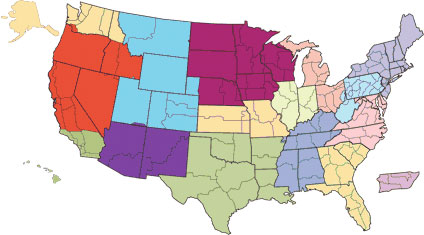Presbyterian Government
In 1797, The General Assembly of the Presbyterian Church in the United States of America adopted the following:
The radical principles of Presbyterian church government and discipline are:
That the several different congregations of believers, taken collectively, constitute one Church of Christ, called emphatically the Church; that a larger part of the Church, or a representation of it, should govern a smaller, or determine matters of controversy which arise therein; that, in like manner, a representation of the whole should govern and determine in regard to every part, and to all the parts united: that is, that a majority shall govern; and consequently that appeals may be carried from lower to higher governing bodies, till they be finally decided by the collected wisdom and united voice of the whole Church. For these principles and this procedure, the example of the apostles and the practice of the primitive Church are considered as authority.
Form of Government, Book of Order, G-1.0400
In simpler words, the Presbyterian Church is a representative democracy which governs itself by representatives chosen from the local congregation. It consists of governing bodies which in turn include more bodies from lower to higher. These bodies are the session, the presbytery, the synod, and the general assembly.
The Constitution of the Presbyterian Church (U.S.A.) which directs the actions of all of these bodies consists of The Book of Confessions and The Book of Order.
The Session
A session governs the local congregation. A session is made up of several elders with the pastor serving as moderator making sure that all voices are heard and that the meetings are run in a way that is fair to everyone. An elder is a male or female member of the congregation who has been chosen to lead the congregation in all of its activities from choosing a paint color for the sanctuary to choosing a new pastor. Elders are the people who answer to God for running the local church. One of these elders is elected to be the Clerk of Session. The Clerk has the job of keeping the minutes and recording all that the session does. A session determines how the congregation as a body will spend its resources and energy in doing the work of God in that location.
The Presbytery
A presbytery is comprised of every minister and at least one elder from each of the congregations in a given region. It determines how several congregations as a body will use their resources and energy in doing the work of God in that area. The presbytery is led by a moderator who is elected from one of the elder or minister members of the presbytery. The moderator is assisted by the presbytery staff which is led by the Stated Clerk of the presbytery. Most presbyteries are organized by regions however a few presbyteries are organized by language/cultural groups.
There are 166 presbyteries in the Presbyterian Church (U.S.A.).
The Synod
A synod is made up of representative members of several presbyteries. It determines how presbyteries as a body will use their resources and energy in doing the work of God in that region. In recent years they have specialized in providing educational opportunities to congregations and providing support persons as congregations reassess their ministries.
There are sixteen synods in the Presbyterian Church (U.S.A.).

- Alaska-Northwest
- Covenant (MI, OH)
- Lakes and Prairies (ND, SD, NE, MN, WI, IA)
- Lincoln Trails (IL, IN)
- Living Waters (KY, TN, MS, AL)
- Mid-America (KS, MO)
- Mid-Atlantic (MD, VA, NC, DE)
- Northeast (NY, NJ, New England)
- Pacific (OR, ID, CA, NV)
- Puerto Rico
- Rocky Mountains (MT, WY, UT, CO)
- South Atlantic (GA, SC, FL)
- Southern California and Hawaii
- Southwest (AZ, NM)
- Sun (TX, OK, AR, LA)
- Trinity (PA, WV)
The General Assembly
The General Assembly is made up of representatives from each Presbytery according to the number of members in the Presbytery. It is the most inclusive ruling body of our denomination the Presbyterian Church (U.S.A.). The Presbyterian Church (U.S.A.), or PCUSA, is currently the largest Presbyterian denomination in the United States with about 9,000 congregations and 1.3 million members.
The General Assembly determines how all the PCUSA congregations in the United States will direct their resources and energy in doing the work of God in this country. It also provides guidance, at the request of lower governing bodies, in how we may organize ourselves, how we may reconcile disputes, and how we should support one another in difficult times. The General Assembly currently meets once every two years. It is led by a Moderator, a ruling elder or a minister, man or woman, who is elected for a two-year term. The Moderator (or Co-Moderators if two are elected as a team) is/are assisted by the General Assembly staff.